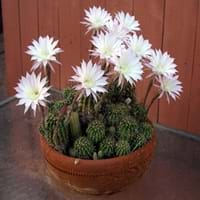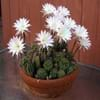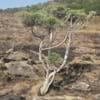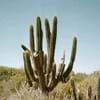Life Span
Perennial
Perennial
Type
Cactus or Succulent
Vegetable
Origin
North America, South America, Brazil
Hybrid origin, Mexico, Central America, South America
Types
Peanut cactus
Not Available
Number of Varieties
Not Available
Habitat
Desert, Sandy areas, Semi desert
Coastal Regions
USDA Hardiness Zone
12-15
11-15
Sunset Zone
12, 13, 16, 17, 21, 22, 23, 24
A1, A2, A3, H1, H2, 1a, 1b, 2a, 2b, 3a, 3b, 4, 5, 6, 7, 8, 9, 10, 11, 12, 13, 14, 15, 16, 17, 18, 19, 20, 21, 22, 23, 24
Habit
Upright/Erect
Upright/Erect
Flower Color
White, Yellow, Red, Purple, Orange, Rose
Yellow
Flower Color Modifier
Not Available
Bicolor
Fruit Color
Green, Orange Red
Red
Leaf Color in Spring
Not Available
Green, Dark Green
Leaf Color in Summer
Not Available
Green, Dark Green
Leaf Color in Fall
Not Available
Green, Dark Green
Leaf Color in Winter
Not Available
Green, Dark Green
Leaf Shape
Succulent
Ovate
Plant Season
Not Available
Spring, Summer, Fall
Sunlight
Full Sun, Partial Sun, Partial shade
Full Sun
Type of Soil
Loam, Sand
Loam, Sand
The pH of Soil
Acidic, Neutral, Alkaline
Neutral
Soil Drainage
Well drained
Well drained
Bloom Time
Spring
Indeterminate
Tolerances
Drought, Dry soil, Full Sun, Heat Tolerance, Rocky Soil
Drought
Where to Plant?
Container, Ground, Pot
Container, Ground
How to Plant?
Grafting, Seedlings, Stem Planting
Grafting, Seedlings
Plant Maintenance
Low
Medium
Watering Requirements
Average Water Needs, Do Not over Water, Never Over-water, Water once every two or three weeks, Water when top layer of soil becomes dry
Needs more water during establishment
In Summer
Average Water
Lots of watering
In Spring
Average Water
Moderate
In Winter
Less Watering
Average Water
Soil pH
Acidic, Neutral, Alkaline
Neutral
Soil Type
Loam, Sand
Loam, Sand
Soil Drainage Capacity
Well drained
Well drained
Sun Exposure
Full Sun, Partial Sun, Partial shade
Full Sun
Pruning
Remove dead or diseased plant parts
Pinch or prune as they grow to promote branching and bushiness
Fertilizers
fertilize in growing season, fertilize in summer, Potassium
14-14-14 Fertilizer, Compost
Pests and Diseases
Mealybugs, Scale
Anthracnose, Aphids, Red blotch, Rust
Plant Tolerance
Drought, Dry soil, Full Sun, Heat Tolerance, Rocky Soil
Heat Tolerance, Salt and Soil Compaction
Flower Petal Number
Single
Single
Fragrant Bark/Stem
No
Yes
Foliage Texture
Bold
Medium
Foliage Sheen
Not Available
Matte
Attracts
Hummingbirds
Aphids, Not Available, Squirrels
Allergy
Skin cuts
Stomach pain, Vomiting
Aesthetic Uses
Beautification, Landscape Designing, Showy Purposes
Used in parkland
Beauty Benefits
No Beauty Benefits
Anti-ageing, Blackheads, Reduce Bruises
Environmental Uses
Air purification, Food for insects, Versatility, Very little waste
Shadow Tree, Soil protection
Medicinal Uses
Burns, Heals minor burns, Heart problems, High blood pressure, Wounds
Dehydration, Diabetes, Diarrhea, Nutrients, Weight loss
Part of Plant Used
Leaves
Fruits
Other Uses
Decoration Purposes, Showy Purposes, Used as Ornamental plant, Used for its medicinal properties
Application in Handicrafts, Food for animals, Showy Purposes
Used As Indoor Plant
Yes
No
Used As Outdoor Plant
Yes
Yes
Garden Design
Container, Houseplant, Rock Garden, Wall
Edible, Herb, Vegetable
Botanical Name
ECHINOPSIS
Manilkara zapota
Common Name
Hedgehog Cactus, Sea urchin cactus
sapodilla , chikoo, Sapota
In Hindi
हाथी कैक्टस
चीकू
In German
Igel Kaktus
Breiapfelbaum
In French
hérisson cactus
Sapotillier
In Spanish
cactus de erizo
chicle
In Greek
κάκτος σκαντζόχοιρος
sapodilla
In Portuguese
hedgehog cactus
sapodilla
In Polish
jeż kaktus
Pigwica właściwa, sapodilla
In Latin
cactus
sapodilla
Phylum
Tracheophyta
Magnoliophyta
Class
Magnoliopsida
Magnoliopsida
Order
Caryophyllales
Ericales
Family
Cactaceae
Sapotaceae
Clade
Angiosperms, Core eudicots, Eudicots
Angiosperms, Asterids, Eudicots
Tribe
Trichocereeae
Sapoteae
Subfamily
Cactoideae
Sapotoideae
Season and Care of Echinopsis and Sapodilla
Season and care of Echinopsis and Sapodilla is important to know. While considering everything about Echinopsis and Sapodilla Care, growing season is an essential factor. Echinopsis season is Not Available and Sapodilla season is Not Available. The type of soil for Echinopsis is Loam, Sand and for Sapodilla is Loam, Sand while the PH of soil for Echinopsis is Acidic, Neutral, Alkaline and for Sapodilla is Neutral.
Echinopsis and Sapodilla Physical Information
Echinopsis and Sapodilla physical information is very important for comparison. Echinopsis height is 30.00 cm and width 15.20 cm whereas Sapodilla height is 150.00 cm and width 60.00 cm. The color specification of Echinopsis and Sapodilla are as follows:
Echinopsis flower color: White, Yellow, Red, Purple, Orange and Rose
Echinopsis leaf color: Not Available
Sapodilla flower color: Yellow
- Sapodilla leaf color: Green and Dark Green
Care of Echinopsis and Sapodilla
Care of Echinopsis and Sapodilla include pruning, fertilizers, watering etc. Echinopsis pruning is done Remove dead or diseased plant parts and Sapodilla pruning is done Pinch or prune as they grow to promote branching and bushiness. In summer Echinopsis needs Average Water and in winter, it needs Less Watering. Whereas, in summer Sapodilla needs Lots of watering and in winter, it needs Average Water.





